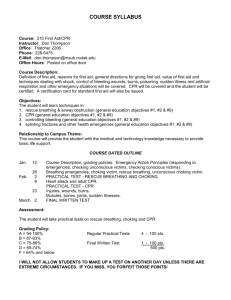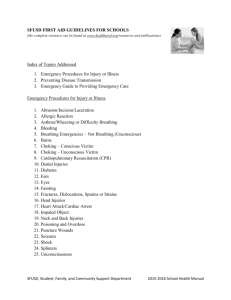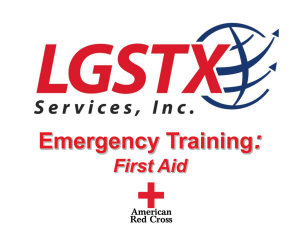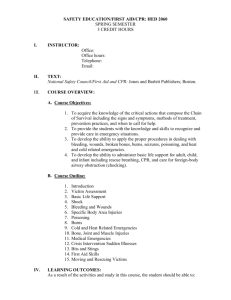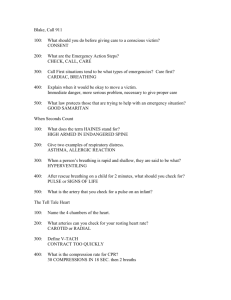AMERICAN RED CROSS ADULT CPR
advertisement
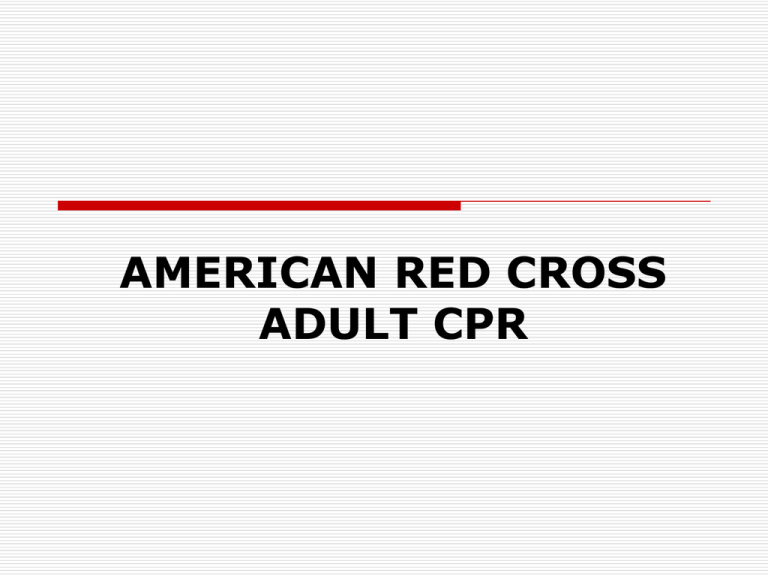
AMERICAN RED CROSS ADULT CPR RECOGNIZING AND RESPONDING TO AN EMERGENCY KEY POINTS By recognizing an emergency and taking immediate action to help, you give a suddenly ill or injured person the best chance for survival Emergencies can often be recognized because of unusual sights, appearances, behaviors, odors or noises OVERCOMING BARRIERS TO ACT KEY POINTS There are many reasons why bystanders do not get involved in an emergency situation It is normal to feel hesitant or unsure about what to do COMMON BARRIERS The presence of other people may lead one to assume that someone else will get involved Uncertainty about the person’s condition. Type of injury or illness. Fear of catching a disease. Fear of doing something wrong Fear of being sued Being unsure of when to call 9-1-1 Ways to overcoming barriers to act Getting trained in first aid, CPR or AED Training to develop the confidence to act, which enables you to take charge until more advanced help arrives Avoiding contact with blood or body fluids by using protective barriers and following standard precautions. Being familiar with Good Samaritan laws and obtaining consent GOOD SAMARITAN LAWS GOOD SAMARITAN LAWS All states have enacted Good Samaritan Laws to protect people who voluntarily give emergency care, without accepting anything in return. GOOD SAMARITAN LAWS These laws may protect you from legal liability as long as you – Act in good faith Are not deliberately negligent or reckless Act within the scope of your training Not abandon the person after starting to give care OBTAINING CONSENT OBTAINING CONSENT You must obtain permission (consent) to help an ill or injured person. If a person refuses care, at least call 9-1-1 or the local emergency number. OBTAINING CONSENT A person who is unconscious, confused or seriously ill may not be able to grant consent. In such cases, consent is implied. Implied consent means that a person would agree to the care if he or she could. OBTAINING CONSENT If the person is a minor, get consent from a parent or guardian, if present; otherwise, consent is implied. Be sure to notify a parent or guardian as soon as possible. Implied consent for a child in a lifethreatening situation means that the parent or guardian would agree for care to be given. OBTAINING CONSENT To obtain consent – State your name Tell the person you are trained in first aid. Ask the person if you can help. Explain what you think may be wrong. Explain what you plan to do. EMERGENCY ACTION STEPS KEY POINTS Always follow the emergency action steps: CHECK – CALL – CARE in any emergency: CHECK the scene for safety and then CHECK the person for life-threatening conditions. CALL 9-1-1 or the local emergency number. CARE for the ill or injured person. KEY POINTS If you are alone, you must decide to Call First or Care First KEY POINTS Call first situations are likely to be cardiac emergencies. Call 9-1-1 or your local emergency number before giving care for An unconscious adult or adolescent age 12 or older A witnessed sudden collapse of a child or infant. An unconscious infant or child known to be at high risk for heart problems KEY POINTS Care First situations are likely to be related to breathing emergencies. Care first (give 2 minutes of care, then call 9-1-1 or your local emergency number) for An unwitnessed collapse of an unconscious person younger than age 12. Any victim of a drowning. MOVING AN ILL OR INJURED PERSON Usually, when you give first aid, you will not have to face hazards that require moving the person immediately. Moving a person can lead to further injury. You should move a person only when you can do so safely and when there is an immediate danger. CHECKING A CONSCIOUS ADULT KEY POINTS For purposes of first aid care, an “adult” is defined as someone who is about 12 years of age or older. After checking the scene, you should check first for life-threatening conditions. Some conditions may become lifethreatening if not recognized and cared for early. KEY POINTS Obtain consent to give care A head-to-toe examination should be done to check the conscious adult. Care for the person based on the conditions found. Take steps to minimize shock RECOGNIZING AND CARING FOR SHOCK KEY POINTS Shock is a life-threatening condition in which not enough blood is being delivered to all parts of the body and can result from injury or illness Shock is likely to develop after any serious injury or illness including severe bleeding, serious internal injury, significant fluid loss or other conditions KEY POINTS A person showing signals of shock needs immediate medical attention Restlessness or irritability Altered level of consciousness Nausea or vomiting Pale, ashen, cool, moist skin Rapid breathing Excessive thirst KEY POINTS Caring for shock includes Call 9-1-1 or your local emergency number immediately. Have the person lie down Elevate the person’s legs about 12 inches unless you suspect head, neck or back injuries or possible broken bones of the hips or legs. Control any bleeding Keep the person from getting chilled or overheated CHECKING AN UNCONSCIOUS ADULT KEY POINTS First, check to make sure the scene is safe Check the person for life-threatening conditions using the “ABCs.” A – Airway B – Breathing C - Circulation KEY POINTS Life-threatening Conditions Unconscious Not breathing or difficulty breathing Choking Persistent chest pain No signs of life Severe bleeding or burns Shock BREATHING EMERGENCIES BREATHING EMERGENCIES A breathing emergency occurs when a person is having trouble breathing (respiratory distress) or is not breathing at all (respiratory arrest). Breathing emergencies can be caused by injury, illness or disease KEY POINTS Choking is a breathing emergency that can lead to death A person’s airway can be partially or completely obstructed. A person with a partial airway obstruction can still move air to and from the lungs, so he or she can cough in an attempt to dislodge the object KEY POINTS A person with a complete airway obstruction is unable to cough, speak or breath. A person who is choking will clutch his or her throat in a gesture known as the universal sign of choking Key Points New method is 5 back blows (to the middle of the shoulder blades) and 5 abdominal thrusts CARDIAC EMERGENCIES CARDIAC CHAIN OF SURVIVAL Cardiopulmonary resuscitation (CPR) alone is not enough to help someone survive a cardiac arrest. Advanced medical care is needed as soon as possible. This is why it is so important to call 9-1-1 immediately CARDIAC CHAIN OF SURVIVAL The greatest chance of survival from cardiac arrest occurs when: 1. Early recognition and early access. The sooner 9-1-1 is called, the sooner early advanced medical care arrives. 2. Early CPR. CPR helps circulate blood containing oxygen to the vital organs until an AED is ready to use or advanced medical personnel arrive. CARDIAC CHAIN OF SURVIVAL 3. Early Defibrillation. Most victims of sudden cardiac arrest need an electrical shock (defibrillation). Each minute that defibrillation is delayed reduces the chance of survival by about 10 percent. CARDIAC CHAIN OF SURVIVAL 4. Early advanced medical care. This is given by trained medical personnel who give further medical care and transport the victim of cardiac arrest to a hospital. CARDIOPULMONARY RESUSCITATION (CPR) KEY POINTS If a person is in cardiac arrest, he or she is unconscious, not breathing and shows no other signs of life. CPR can help circulate blood that contains oxygen to vital organs by a combination of chest compressions and rescue breaths. KEY POINTS Place overlapping hands in center of chest on the lower half of the sternum. While keeping elbows straight, compress chest 1 1/2 to 2 inches. Breathe until the chest rises (about 1 second per breath. Perform cycles of 30 compressions (18 seconds or 100/minute) and 2 breaths. UNCONSCIOUS CHOKING KEY POINTS If you attempt rescue breaths but are unable to make the chest clearly rise, you must act quickly to get air into the person. Care for an unconscious choking adult is very similar to adult CPR with the exception that you look for a foreign object between compressions and breaths. Chest compressions are used to help force air from the person’s lungs to dislodge the object.
